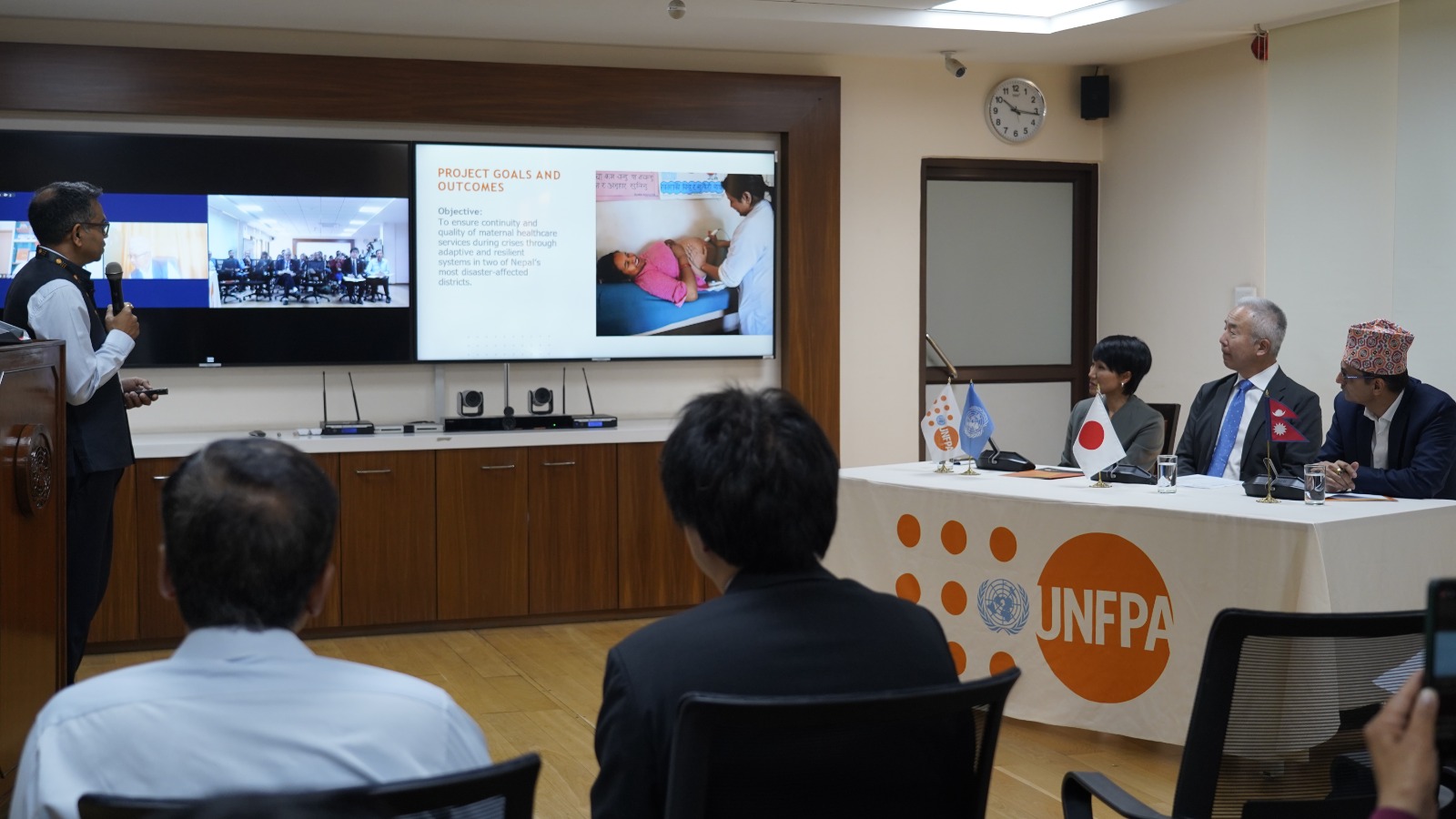Buddhi Prasad Acharya is Managing Director of Nepal Telecom. He was appointed to the post in July 2014 for a period of two years. Acharya, who is to soon complete his term in office, talked to Onlinekhabar recently about the highlights of his tenure. Translated excerpts:
First of all, could you list some of your achievements as Nepal Telecom’s MD in the last two years?
As you know, in the telecom business, companies like NTC need to work both on providing services and building infrastructure, which is not an easy job. That is why two years in this business is not a very long time.
“When I became MD, my focus was on concluding projects that had been pending for long, even for years in some cases.”
When I became MD, my focus was on concluding projects that had been pending for long, even for years in some cases. It was during my tenure that we aggressively expanded the coverage of our 3G service, we decided to make use of CDMA technology to provide telecom services to people in rural areas. We also started our Wimax service.
One of the highlights of my tenure was the introduction of the convergent billing system, which allows us to roll out different packages for voice as well as data. Similarly, an agreement to switch to IP system from TDM, which will increase the quality of data services such as ADSL, was reached during my term in office.
The laying down of optical fiber network to connect Nepal to Hong Kong via Kerung is also another achievement. This development will have a big impact on the telecom sector in Nepal.
What are your achievements in terms of corporate governance, and overall profitability of the company?
Well, corporate governance reforms was also an important milestone during my tenure. We adopted a model to decentralise authority and responsibilities. In the past, every decision had to be taken by the Managing Director, but now we have established several business units that have the authority to make decisions. Similarly, we introduced a voluntary retirement scheme to make the organisation more efficient. More than 500 employees opted for it.
“We were able to offer 50 per cent dividend to our shareholders. The government itself received Rs 7 billion in dividend, which is a huge amount in itself.”
In terms of revenue, the figure was already growing by Rs 1 billion every year when I was appointed MD. The first year after I took charge, revenue grew by Rs 3 billion. Profitability also increased. We were able to offer 50 per cent dividend to our shareholders. The government itself received Rs 7 billion in dividend, which is a huge amount in itself.
And in terms of market share?
Two years ago, our overall market share was around 44 per cent, it has now increased to 48 per cent, mainly driven by mobile phone users.
In terms of coverage, our services are available in around 80 per cent of the country. We are working on extending our network even by using VSat if it becomes necessary.
What was the most challenging part of the job for you?
The challenge was to decentralise the decision-making process in our company. We established different business units to decide on things more locally.
Was there anything you wanted to do, but could not?
Well, we wanted to extend our coverage to various rural areas. Although we did make progress in that regard, we could have done much more. The other thing I wanted to do was to expand our optical fiber network. But there were lot of challenges to doing that.
“I must say that Nepal Telcom is not short on funds, but it has other constraints.”
I must say that Nepal Telcom is not short on funds, but it has other constraints. For example, we cannot take prompt decisions, due to the regulatory environment we are working in.
When you became MD of Nepal Telecom, there were people who were opposed to your appointment because you are a Chartered Accountant, not an engineer. Did that hamper your performance?
What you are talking about, happened in the first few weeks. But after that, everyone realised that the issue was not important, and there were more important things to deal with. It is not an issue now.
Now let’s talk about a development that also made headlines in the international press. Could you tell us when will Nepal Telecom launch the commercial operation of Nepal-China cross-border optical fiber link?
Well, till now we had been relying on India for internet bandwidth. We are connected to India at around five different points. Nepal and China had agreed to establish optical fiber connection via Tatopani and Kerung. The Kerung line is already being tested, while work on the Tatopani line is also on; it had to be halted because of the recent floods and landslides in the area.
“Billions of calls between India and China can be routed through the new optical fiber link, and this will add revenue for us.”
The new optical fiber links will have two-fold benefits. First, the price of internet bandwidth will go down as we have two options. Similarly, billions of calls between India and China can be routed through it, and this will add revenue for us. At the end of the day, internet will become cheaper faster, and more reliable. Whenever, our cost goes down, we will immediately transfer the cut to the users, and that will help bring down prices.
What about the progress in laying optical fiber along the Mid-hill highway?
We have already signed deals with the telecoms regulator for doing that. We will be using the rural development fund to expand our network.
The other thing that you need to note is that we want all telecom players to be able to use our infrastructure. We do not want competing companies to invest in the same thing. We live in a country where everything has to be imported, and measures to save on hard-earned foreign currency should be a priority. So, there’s no point in building redundant infrastructure.

When Onlinekhabar interviewed you after being appointed to this post. You said your focus would be on rolling out data packages for mobile phone users, and NTC did roll out data packages for its users. How has the response been like?
The response has been overwhelming. The fifty rupee, and the 200 rupee packages have been the most popular ones. Our subscribers are using 3G so much that we have had to increase our bandwidth on a regular basis.
What percentage of revenue comes from data services?
In our case, around 80 per cent of our revenue is coming from voice calls, despite the recent boom in data usage. I think the main reason for this is that calls within the NTC network are relatively cheaper. But looking at the trend, I think that people these days are more interested in communicating than making voice calls. They like to use text, either through SMS or OTT services. That is why if we look at figures per capita, the revenue from data is higher than that of voice calls.
Could you tell us how your company views over the top services such as Viber, Whatsapp, and the like?
I think the rise of OTT will ultimately benefit telecos because the services rely on internet, and internet can only be provided by the telecos. OTT is going to be big in the future, and we cannot stop it even if we want to.
Our strategy should be to develop services such as OTT on our own so that we can save on precious bandwidth. I personally feel that the government should also encourage this.
The Cabinet has recently revised its policy on 4G services. When can we expect NTC to roll out 4G?
Yes, the government recently revised its policy. I would like to say that we will launch the service within two months of getting a permit from the regulator to do so.
We do not have any 4G equipment with us at the moment. The procedure to acquire new equipment is a bit long in our case as we have to follow the Public Procurement Act. But despite the challenge, I am confident that we will launch 4G within two months of getting the licence.
As you may already know, 4G is an advanced version of 3G, with its introduction, internet becomes faster. You can use it to stream videos, make video calls, and so on. You can even use it on your phone to create wifi hotspots to share your internet connection.
The ITU has already said that 5G services will be ready by 2020. I want the company to be ready to adopt the technology as soon as it is rolled out in the developed world.
How will the pricing be?
We do not yet have the equipment. So I can’t give you a precise number. But I can say for sure that we are not looking to make huge profits out of this. So the price will be competitive.
Another of your popular services is ADSL. But the service’s quality has been question a lot. Do you have plans to improve its quality?
Our goal is to develop ADSL as our broadband internet service. As you may know, we rely on our existing telephone network for the service. The network is bit old, and the cables need to be replaced. Similarly, we have observed that signal loss is high in areas that are far from our exchange.
So what we are doing is migrating from an old technology to the latest IP technology, replacing the cables, and establishing more exchanges to make ADSL more reliable and fast. Although the entire process will take three years to complete, subscribers in Kathmandu will be able to feel the difference soon.

Could you tell us about the fiber to home service? How has the response been?
The response has been overwhelming. We first introduced the service for corporate clients, as the price was a bit high. But individual subscribers were also ready to pay for it. So we want to expand it as hi-end internet service. We want to take the service to major towns in Nepal.
The other project which was a bit controversial was the Meet service, which was supposed to become a popular social network. Do you think it failed?
Well, the project was approved in 2012, and it had been pending for years. As I said earlier, as part of my plan to complete all pending projects, the service was launched in 2015.
The service is now being used by our staffers as an internal network. After what happened following the launch of Meet, we did inspect the vendor’s servers and looked back at the papers. but there was nothing abnormal about it.
In fact, the service is becoming popular. For example, during the recent NC convention, people used it to send bulk SMSes. We expect people to use it to send greetings during the festive season.
Now that your tenure is about to be over, would you like to apply for the post again?
As I said, two years is not a long time in telecom business. But it is the government that will decide, who it wants to become MD. If they think I am the right person for the job, I would be glad to oblige.























